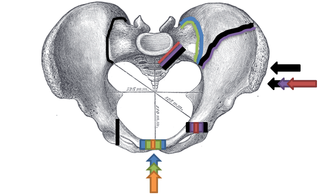Pelvic fracture

Editor-In-Chief: Prab R Tumpati, MD
Obesity, Sleep & Internal medicine
Founder, WikiMD Wellnesspedia &
W8MD medical weight loss NYC and sleep center NYC
| Pelvic fracture | |
|---|---|

| |
| Synonyms | N/A |
| Pronounce | N/A |
| Specialty | N/A |
| Symptoms | Pelvic pain, hip pain, lower back pain, leg pain, difficulty walking |
| Complications | Hemorrhage, nerve injury, organ damage, deep vein thrombosis, pulmonary embolism |
| Onset | Sudden, typically due to trauma |
| Duration | Varies, depending on severity and treatment |
| Types | N/A |
| Causes | High-energy trauma (e.g., motor vehicle collision, fall from height), low-energy trauma in osteoporotic patients |
| Risks | Osteoporosis, advanced age, high-impact sports |
| Diagnosis | Physical examination, X-ray, CT scan |
| Differential diagnosis | Hip fracture, sacroiliac joint dysfunction, lumbar spine injury |
| Prevention | N/A |
| Treatment | Pain management, physical therapy, surgical fixation |
| Medication | N/A |
| Prognosis | Varies, depending on severity and associated injuries |
| Frequency | Common in trauma centers |
| Deaths | N/A |



File:PelvicBinding.webm A pelvic fracture is a break in one or more bones of the pelvis. The pelvis is a ring-like structure of bones located at the lower end of the trunk.
Causes[edit]
Pelvic fractures can occur as a result of high-energy events, such as car or motorcycle crashes, falls from significant heights, and crushing accidents. They can also occur in people with osteoporosis who sustain a low-energy fall.
Symptoms[edit]
Symptoms of a pelvic fracture may include pain and tenderness in the groin or hip area, difficulty walking or standing, and in severe cases, internal bleeding which can lead to shock.
Diagnosis[edit]
Diagnosis of a pelvic fracture is typically made through a combination of physical examination and imaging tests, such as X-rays, CT scans, or MRIs.
Treatment[edit]
Treatment for a pelvic fracture depends on the severity of the injury. Mild fractures may be treated with rest, pain medication, and physical therapy. Severe fractures may require surgery to realign the bones and stabilize the pelvis.
Prognosis[edit]
The prognosis for a pelvic fracture depends on the severity of the fracture and the patient's overall health. With proper treatment, most people can expect to make a full recovery.
See Also[edit]
Ad. Transform your life with W8MD's Budget GLP-1 injections from $75


W8MD offers a medical weight loss program to lose weight in Philadelphia. Our physician-supervised medical weight loss provides:
- Weight loss injections in NYC (generic and brand names):
- Zepbound / Mounjaro, Wegovy / Ozempic, Saxenda
- Most insurances accepted or discounted self-pay rates. We will obtain insurance prior authorizations if needed.
- Generic GLP1 weight loss injections from $75 for the starting dose.
- Also offer prescription weight loss medications including Phentermine, Qsymia, Diethylpropion, Contrave etc.
NYC weight loss doctor appointmentsNYC weight loss doctor appointments
Start your NYC weight loss journey today at our NYC medical weight loss and Philadelphia medical weight loss clinics.
- Call 718-946-5500 to lose weight in NYC or for medical weight loss in Philadelphia 215-676-2334.
- Tags:NYC medical weight loss, Philadelphia lose weight Zepbound NYC, Budget GLP1 weight loss injections, Wegovy Philadelphia, Wegovy NYC, Philadelphia medical weight loss, Brookly weight loss and Wegovy NYC
|
WikiMD's Wellness Encyclopedia |
| Let Food Be Thy Medicine Medicine Thy Food - Hippocrates |
Medical Disclaimer: WikiMD is not a substitute for professional medical advice. The information on WikiMD is provided as an information resource only, may be incorrect, outdated or misleading, and is not to be used or relied on for any diagnostic or treatment purposes. Please consult your health care provider before making any healthcare decisions or for guidance about a specific medical condition. WikiMD expressly disclaims responsibility, and shall have no liability, for any damages, loss, injury, or liability whatsoever suffered as a result of your reliance on the information contained in this site. By visiting this site you agree to the foregoing terms and conditions, which may from time to time be changed or supplemented by WikiMD. If you do not agree to the foregoing terms and conditions, you should not enter or use this site. See full disclaimer.
Credits:Most images are courtesy of Wikimedia commons, and templates, categories Wikipedia, licensed under CC BY SA or similar.
Translate this page: - East Asian
中文,
日本,
한국어,
South Asian
हिन्दी,
தமிழ்,
తెలుగు,
Urdu,
ಕನ್ನಡ,
Southeast Asian
Indonesian,
Vietnamese,
Thai,
မြန်မာဘာသာ,
বাংলা
European
español,
Deutsch,
français,
Greek,
português do Brasil,
polski,
română,
русский,
Nederlands,
norsk,
svenska,
suomi,
Italian
Middle Eastern & African
عربى,
Turkish,
Persian,
Hebrew,
Afrikaans,
isiZulu,
Kiswahili,
Other
Bulgarian,
Hungarian,
Czech,
Swedish,
മലയാളം,
मराठी,
ਪੰਜਾਬੀ,
ગુજરાતી,
Portuguese,
Ukrainian


